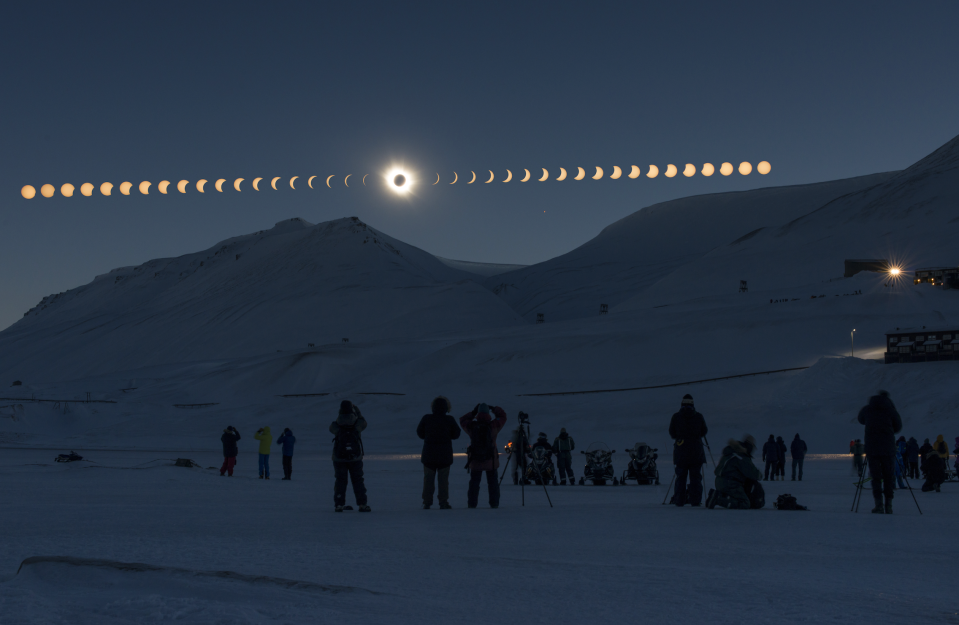'Celestial event of the century': As April 8 approaches, look back at the 1925 eclipse
It was hailed as a "once-in-a-lifetime" event for Utica and the Upper Mohawk Valley region, and it happened on a bitter cold, clear Saturday morning on Jan. 24, 1925.
The last total solar eclipse over the region occurred on August 7, 1869. The next one, the Observer-Dispatch reminded its readers in 1925, would not happen again for 99 years -- on Monday, April 8, 2024.

In 1925, there were the usual warnings. Never look directly at the sun without smoked or tinted glasses or eye protection.
The moon would be lining up between Earth and the sun beginning at 8:02. The eclipse would end at 10:29. Maximum obscuration would occur at 9:13 when 99 percent of the sun would be blocked by the moon.
As early as 7 a.m., hundreds of people gathered in downtown Utica, finding their way to the rooftops of the city's tallest buildings. The most popular were downtown's two 10-story buildings -- the Hotel Utica and the City Insurance Building on Lower Genesee Street. (The hotel would add four stories in 1926 and the 14-story Adirondack Building had not yet been built.)
Those who remained on the ground crowded together at several downtown intersections. For some reason, the most popular spots that attracted the largest crowds were at Busy Corner, and at Bleecker and Charlotte streets and Genesee and Elizabeth Streets.
Of course, the neighborhood streets also were crowded as the bitter cold -- 18 below zero only a few hours earlier -- failed to keep people indoors.
Most of the city's factories, knitting mills, stores, businesses and offices that normally worked five-and-a-half days a week -- including, of course, Saturday mornings -- were closed to give their employees the opportunity to see the great event.
Most Uticans had pieces of smoked glass in their hands as they waited for 8:02 to arrive. Jones & Gurley paint, wallpaper and glass store -- at 52 Franklin Square -- had run a quarter-page ad in the Observer-Dispatch that read: "We will gladly give, without obligation, to everyone who calls at our store, a piece of smoked glass to see the eclipse."
Dozens of people took advantage of the offer.
Also, officials with the Utica Fire Department had invited Uticans to bring a piece of glass to the Central Fire Station, at Elizabeth and Burnet Streets, where firefighters would carefully light a fire under the glass to "smoke" and darken it.
Just minutes before 8:02, R.M Vollmer, chief dispatcher for the Utica Gas & Electric Company, pulled a switch that turned on all city streetlights.
At 8:01, an eerie silence hung over the city.
Then, on schedule, daylight began to fade away. The silence was interrupted by "oohs" and "aahs." House lights were turned on throughout the city and Vollmer later reported that the gas and electric company had experienced during the eclipse "its heaviest load in its history."
The eclipse ended at 10:29 and Uticans witnessed an event that many would remember for the rest of their lives.
That evening, the Observer-Dispatch --an afternoon newspaper at the time -- ran a large headline and subheads across its front page that read: “CELESTIAL EVENT OF CENTURY WITNESSED IN UTICA ... Daylight Fades Away As Sky Gazers Watch Sun Diminish to Tiny Crescent ... Bitter Cold Morning Fails to Keep People Inside.”
The following Monday, the Utica Daily Press -- a morning newspaper -- editorialized: "The recent total solar eclipse taught us that there is nothing more important to the world than the sun. It is Earth's power plant. It gives us light, heat, wind, wood, food, coal and nearly all other activities on Earth are depended on the sun."
There were no reports of damaging incidents during the eclipse.
Professional and amateur photographers were busy, though, for on Monday morning, the Observer-Dispatch received more than 100 photos of the eclipse in the mail.
Several appeared in the Monday afternoon O-D.
This article originally appeared on Observer-Dispatch: Solar eclipse 2024: A historical look at the last total solar eclipse

